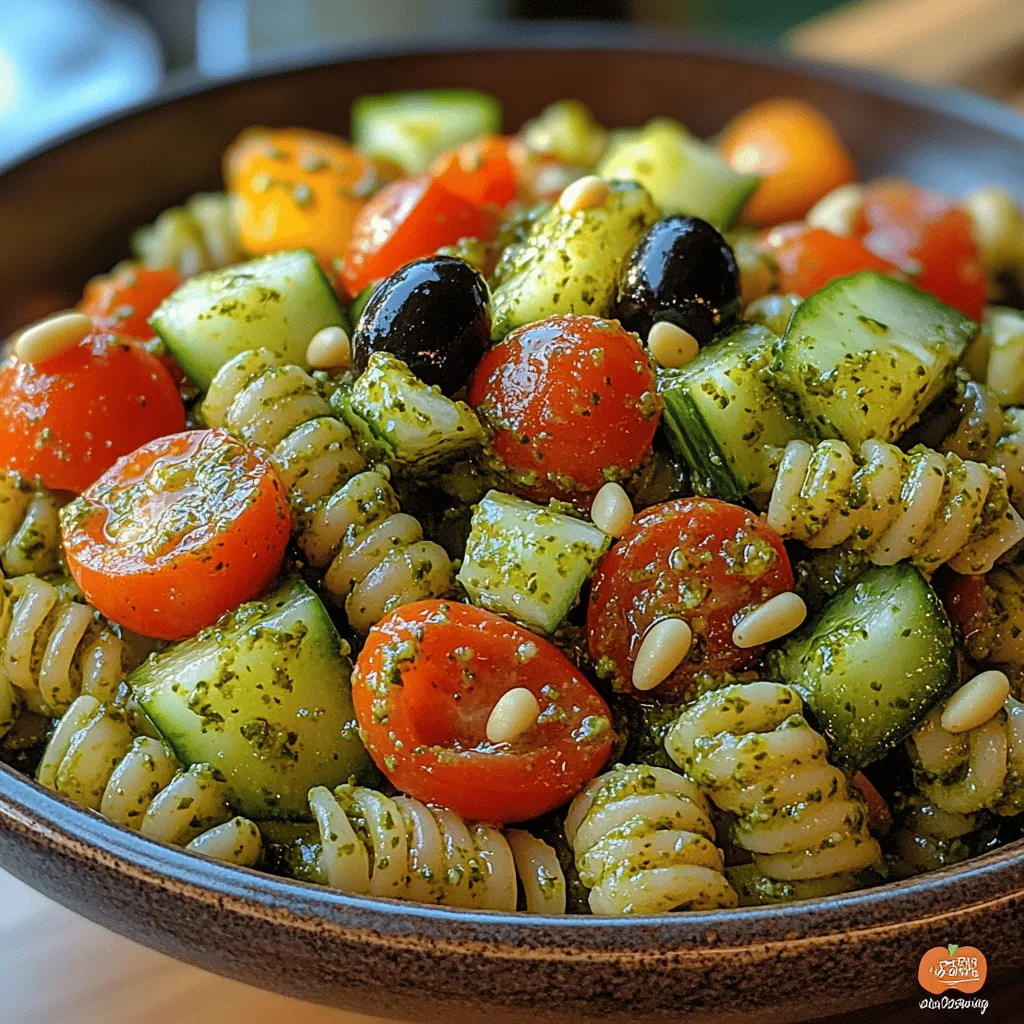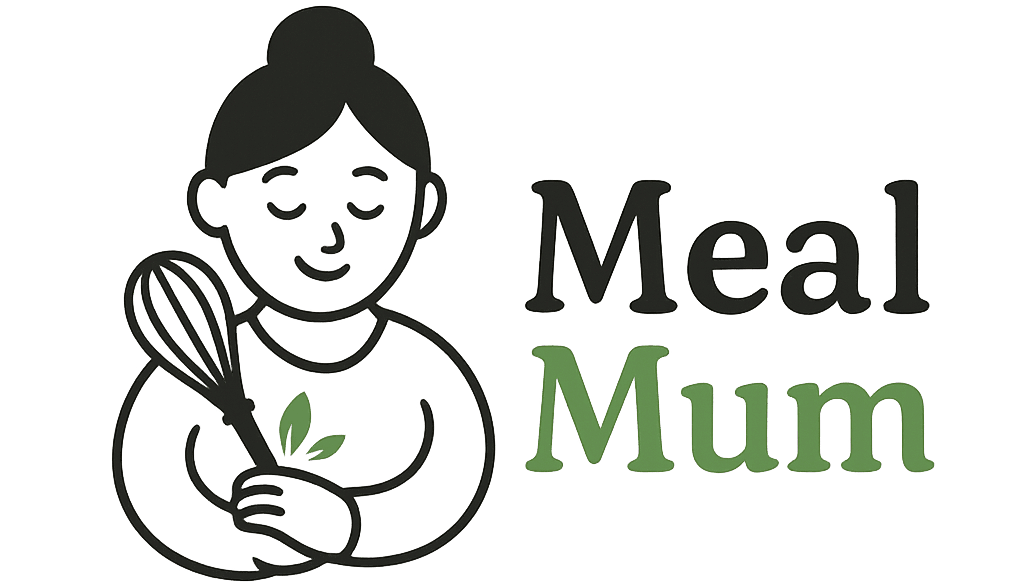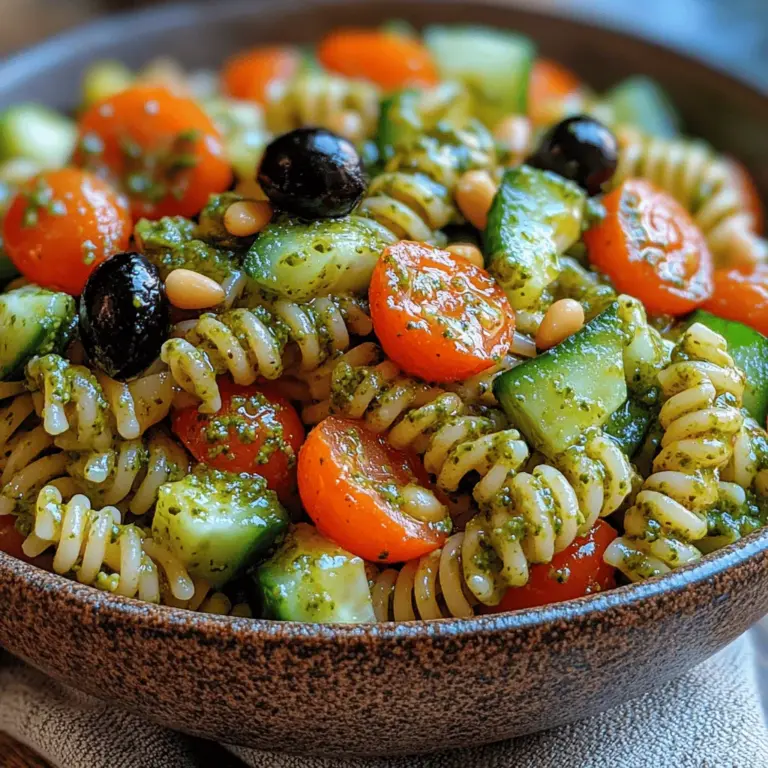Introduction
As summer approaches, the allure of pasta salad becomes irresistible. These vibrant, colorful dishes are perfect for warm-weather gatherings and provide a fantastic way to incorporate fresh ingredients into your diet. One standout option is the basil pesto pasta salad—a refreshing and nutritious dish that combines the aromatic flavors of fresh basil with the satisfying texture of pasta. Whether you are hosting a picnic, attending a barbecue, or simply looking for a light meal, this pasta salad is versatile enough to fit any occasion.
The beauty of a basil pesto pasta salad lies not only in its flavor but also in its health benefits. By using whole grain pasta, you can elevate this dish with added fiber and nutrients that promote overall well-being. Whole grain pasta is an excellent choice for those looking to maintain energy levels throughout the day while enjoying a delicious meal. Coupled with fresh ingredients and a homemade pesto, this salad becomes a wholesome option that can be enjoyed guilt-free.
In this article, we will explore the key components of the refreshing basil pesto pasta salad, including their health benefits and how they contribute to the dish’s overall appeal. We’ll also guide you through the steps to create your own basil pesto from scratch, providing tips to ensure the perfect texture and flavor. Let’s dive into the ingredients that make this pasta salad a must-try this summer!
Understanding the Ingredients
Key Components of the Recipe
To create a delightful basil pesto pasta salad, it’s essential to understand the key ingredients that bring this dish to life. The primary components include whole grain pasta, fresh basil, pine nuts, Parmesan cheese, and a medley of colorful vegetables. Each ingredient plays a vital role in both flavor and nutrition, making this salad a well-rounded meal.
Benefits of Using Whole Grain Pasta
Whole grain pasta is the foundation of this salad, providing not only a satisfying base but also numerous health benefits. Unlike refined pasta, whole grain options retain the bran and germ, which are packed with fiber, vitamins, and minerals. The fiber content aids in digestion and helps to keep you feeling full longer, making it an excellent choice for maintaining a healthy weight. Additionally, whole grain pasta has a lower glycemic index, which means it can help regulate blood sugar levels.
Importance of Fresh Basil in Pesto
Fresh basil is the star of the show when it comes to pesto. With its aromatic, slightly peppery flavor, basil adds a vibrant freshness that elevates any dish. Beyond its taste, basil is also rich in antioxidants and has anti-inflammatory properties, making it a fantastic addition to your diet. When blended into pesto, fresh basil creates a smooth, fragrant sauce that coats the pasta beautifully, imparting its delicious flavor throughout the salad.
The Role of Pine Nuts
Pine nuts are another essential ingredient in traditional pesto. These small, nutrient-dense nuts contribute a rich, buttery flavor that enhances the overall taste of the pesto. They are also packed with healthy fats, protein, and essential vitamins and minerals. Incorporating pine nuts into your salad not only enriches the flavor but also adds a satisfying crunch that contrasts beautifully with the tender pasta and vegetables.
Significance of Parmesan Cheese
Parmesan cheese is a critical component of pesto, adding a savory umami flavor that balances the freshness of the basil and the richness of the pine nuts. This aged cheese also provides a creamy texture that helps bind the ingredients together. While traditional pesto recipes call for dairy, there are options for those looking to make a dairy-free version. Nutritional yeast can be used as a substitute, providing a cheesy flavor without the dairy.
Additional Ingredients
To make the basil pesto pasta salad even more vibrant and nutritious, we will be adding a colorful assortment of vegetables. Cherry tomatoes, cucumber, and red bell pepper not only enhance the salad’s visual appeal but also contribute essential vitamins and minerals. Cherry tomatoes provide a sweet burst of flavor, while cucumbers add a refreshing crunch. Red bell peppers are rich in vitamin C and antioxidants, making them a healthy addition to this dish. For those who enjoy a briny flavor, optional black olives can be included to further enhance the taste profile.
Step-by-Step Guide to Making Basil Pesto
Creating fresh basil pesto at home is simpler than you might think, and it allows you to control the ingredients and flavors. Here’s a detailed guide to making the perfect pesto that will complement your pasta salad beautifully.
Ingredients for Basil Pesto
– 2 cups fresh basil leaves, packed
– 1/2 cup pine nuts (or walnuts, for a different flavor)
– 1/2 cup freshly grated Parmesan cheese (or nutritional yeast for a dairy-free option)
– 2-3 cloves garlic, minced
– 1/2 cup extra virgin olive oil
– Salt and pepper to taste
– Juice of 1/2 lemon (optional, for brightness)
Instructions
1. Prepare the Basil: Start by rinsing the fresh basil leaves thoroughly under cold water to remove any dirt or impurities. Pat them dry with a clean kitchen towel or use a salad spinner to remove excess moisture.
2. Toast the Nuts: For enhanced flavor, consider lightly toasting the pine nuts in a dry skillet over medium heat. Stir them frequently to prevent burning, and remove them from the heat once they are golden and fragrant. Allow them to cool before adding them to the blender.
3. Combine Ingredients: In a food processor, combine the basil leaves, toasted pine nuts, grated Parmesan cheese, and minced garlic. Pulse these ingredients together until they are finely chopped and well combined.
4. Emulsification Process: While the food processor is running, slowly drizzle in the extra virgin olive oil. This emulsification process is crucial as it creates a smooth, cohesive pesto. Continue blending until the mixture reaches your desired consistency—smooth but still slightly chunky.
5. Season to Taste: Once blended, taste the pesto and adjust the flavors as needed. Add salt and pepper to enhance the flavors, and if desired, a squeeze of lemon juice for a touch of acidity that brings all the ingredients together.
Common Questions About Pesto Preparation
– Can I substitute the pine nuts? Yes! If pine nuts are hard to find or too expensive, walnuts, pecans, or even sunflower seeds can be great alternatives that still provide a delicious flavor.
– Is there a dairy-free option? Absolutely! For a dairy-free pesto, simply omit the Parmesan cheese and substitute it with nutritional yeast, which will give a similar cheesy flavor.
– How can I store leftover pesto? Pesto can be stored in an airtight container in the refrigerator for up to a week. To preserve its vibrant green color, drizzle a thin layer of olive oil on top before sealing.
Cooking the Pasta Perfectly
The next step in preparing your basil pesto pasta salad is cooking the pasta to perfection. Achieving the ideal al dente texture is essential, as it ensures the pasta holds up well when combined with the pesto and vegetables.
Guidelines for Cooking Pasta
1. Select Your Pasta: Choose a pasta shape that will hold the pesto well. Short shapes like fusilli, penne, or farfalle work wonderfully, but you can also use long shapes like spaghetti or linguine if preferred.
2. Boil Water: Fill a large pot with water and bring it to a rolling boil. Adding salt to the water is crucial, as it infuses the pasta with flavor during cooking.
3. Cook Until Al Dente: Add the pasta to the boiling water and cook according to the package instructions until it reaches an al dente texture. This typically takes about 8-10 minutes, depending on the type of pasta. Al dente pasta should be tender but still firm to the bite.
4. Rinse and Cool: Once cooked, drain the pasta in a colander. To stop the cooking process and prevent stickiness, rinse the pasta under cold water. This will cool it down and make it perfect for your salad.
5. Explore Pasta Shapes: While the recipe can accommodate various pasta shapes, consider trying whole grain options like whole wheat rotini or chickpea pasta for added nutrition and flavor.
Combining Ingredients for the Perfect Salad
Once you have prepared the basil pesto and cooked the pasta, you are ready to combine all the ingredients for your refreshing basil pesto pasta salad. The key is to ensure that each component is well-coated with the pesto, allowing the flavors to meld beautifully.
Stay tuned for the next section, where we’ll dive into the final assembly and presentation of your delicious basil pesto pasta salad!

Tips for Mixing Pasta and Vegetables Without Damaging the Ingredients
When preparing your refreshing Basil Pesto Pasta Salad, the way you mix your pasta and vegetables can significantly affect the texture and presentation of the dish. Here are some essential tips to ensure a perfect blend without damaging the ingredients:
1. Let Pasta Cool: After cooking the pasta, allow it to cool slightly before mixing it with the vegetables. This prevents the heat from wilting the fresh ingredients and maintains their crispness.
2. Use Gentle Folding Techniques: Instead of vigorous stirring, use a gentle folding technique to combine the pasta with the vegetables and pesto. This method helps retain the shape of the veggies and prevents the pasta from breaking apart.
3. Add Ingredients Gradually: Start by adding the pasta to a large mixing bowl, followed by the pesto. Gradually introduce your vegetables, folding them in carefully. This helps in achieving an even distribution without squashing sensitive ingredients.
4. Opt for Bite-Sized Pieces: When preparing vegetables, cut them into bite-sized pieces. This makes it easier to mix them in without damaging their form. For example, halved cherry tomatoes and chopped bell peppers work beautifully.
5. Add Pesto in Portions: To avoid overwhelming any single ingredient with pesto, add it in portions. Mix thoroughly after each addition until all ingredients are evenly coated, ensuring every bite is full of flavor.
Suggestions on Additional Vegetables or Proteins That Can Complement the Salad
To elevate your Basil Pesto Pasta Salad even further, consider incorporating additional vegetables or proteins. Here are some suggestions:
– Grilled Chicken: For an added protein boost, grilled chicken breast, sliced into strips, can make the salad more filling and satisfying. Its smoky flavor complements the freshness of the pesto beautifully.
– Roasted Vegetables: Incorporating roasted seasonal vegetables like zucchini, bell peppers, or asparagus adds depth and richness to the salad. Roast them lightly with olive oil, salt, and pepper before mixing them in.
– Chickpeas: For a vegetarian protein source, canned chickpeas are a fantastic addition. They provide a nutty flavor and a healthy dose of fiber.
– Fresh Spinach or Arugula: Tossing in some fresh leafy greens not only enhances the nutritional value but also adds a lovely crunch and peppery flavor, especially with arugula.
– Olives or Artichokes: For a Mediterranean twist, consider adding sliced olives or marinated artichokes. These ingredients introduce a briny flavor that contrasts beautifully with the creamy pesto.
Visual Appeal: The Importance of Color and Texture in a Pasta Salad
A key aspect of any successful dish is its visual appeal, and pasta salads are no exception. The vibrant colors and varied textures can make your Basil Pesto Pasta Salad not only delicious but also a feast for the eyes. Here are some pointers to enhance the visual appeal:
– Color Variety: Aim for a rainbow of colors in your salad. The bright green of basil pesto, the rich yellow of bell peppers, the deep red of cherry tomatoes, and the earthy tones of roasted vegetables create a visually stunning dish.
– Texture Contrast: Incorporate different textures for a more interesting mouthfeel. Combine creamy pesto with crunchy vegetables like bell peppers and cucumbers, as well as soft elements like mozzarella balls or grilled chicken.
– Garnishing: A simple garnish can elevate the presentation. Consider sprinkling some toasted pine nuts or walnuts on top for added texture, or a few fresh basil leaves for a pop of green.
Chilling and Serving the Salad
Chilling your Basil Pesto Pasta Salad is a crucial step that enhances the dish’s overall flavor and texture.
Why Chilling Enhances Flavor
When you allow the salad to chill in the refrigerator for at least 30 minutes to an hour, the flavors have time to meld together. The pesto infuses the pasta and vegetables with its aromatic qualities, resulting in a more cohesive taste. The cool temperature also makes the salad more refreshing, particularly on a hot day.
Suggested Serving Ideas and Garnishes
To serve your pasta salad, consider these ideas to make it even more delightful:
– Add Extra Lemon Juice: A squeeze of fresh lemon juice just before serving can brighten the flavors and add a refreshing zing.
– Fresh Herbs: Garnish with additional fresh herbs like parsley or chives to enhance the herbaceous notes in the pesto.
– Cheese Crumbles: Sprinkle some crumbled feta or shaved Parmesan on top for a salty, creamy finish.
– Serve in Individual Bowls: For a more elegant presentation, serve the salad in individual bowls or on a platter with garnishes artfully arranged around the salad.
Nutritional Benefits of Basil Pesto Pasta Salad
Basil Pesto Pasta Salad is not just delicious; it also boasts a host of nutritional benefits:
Overall Nutritional Profile
This dish is a well-rounded meal that includes carbohydrates from the pasta, healthy fats from the olive oil and nuts in the pesto, and a variety of vitamins and minerals from the fresh vegetables. It’s a great source of energy and essential nutrients.
Health Benefits of the Main Ingredients
– Basil: Fresh basil is rich in antioxidants and contains anti-inflammatory properties. It’s a good source of vitamins A, K, and C, which support immune function and bone health.
– Vegetables: The assortment of vegetables provides essential vitamins, minerals, and fiber. For instance, tomatoes are high in vitamin C and lycopene, while bell peppers are loaded with vitamins A and B6.
– Whole Grains: If you opt for whole grain pasta, you increase the fiber content of the dish, which is beneficial for digestive health and can help regulate blood sugar levels.
Variations of the Basil Pesto Pasta Salad
One of the best aspects of Basil Pesto Pasta Salad is its versatility. Here are some variations to keep the dish exciting:
Different Types of Pesto
– Spinach Pesto: Swap out traditional basil for spinach to create a milder, nutrient-rich pesto. This variation is particularly appealing for those looking to increase their iron intake.
– Arugula Pesto: For a peppery flavor, use arugula in your pesto. It adds a unique twist and pairs well with the other salad ingredients.
– Sun-Dried Tomato Pesto: This variation offers a deeper, richer flavor profile. The sweetness of sun-dried tomatoes complements the savory elements of the salad.
Seasonal Variations
Adapt your pasta salad based on what’s in season:
– Spring: Add in fresh asparagus, peas, and radishes for a light and vibrant spring salad.
– Summer: Incorporate fresh corn, zucchini, and cherry tomatoes for a bright summer mix.
– Fall: Consider roasted butternut squash, Brussels sprouts, or cranberries for a heartier fall-inspired salad.
Making the Dish Vegan or Gluten-Free
– Vegan Version: To make this salad vegan, use nutritional yeast instead of cheese in your pesto and ensure your pasta is egg-free.
– Gluten-Free Option: Substitute regular pasta with gluten-free alternatives made from chickpeas, lentils, or brown rice.
Storage and Meal Prep Tips
Proper storage of your Basil Pesto Pasta Salad ensures it stays fresh and delicious for days.
Best Practices for Storing Leftover Pasta Salad
– Airtight Containers: Store the salad in an airtight container in the refrigerator. This prevents moisture loss and protects the salad from absorbing unwanted odors.
– Keep Dressing Separate: If you anticipate leftovers, consider dressing only a portion of the salad. Store the remaining pesto separately and mix it in fresh when serving to maintain the salad’s texture.
Ideas for Meal Prepping This Dish
– Batch Cooking: Prepare a large batch of the salad at the beginning of the week. It makes for an easy grab-and-go lunch or dinner option.
– Portion Control: Divide the salad into individual containers for portion control, making it easy to take to work or school.
Flavor Development Over Time
Pasta salads often taste better the next day as flavors continue to meld. However, if you’re storing it for more than a couple of days, keep an eye on the freshness of the vegetables and the texture of the pasta.
Conclusion
The refreshing nature and versatility of Basil Pesto Pasta Salad make it a staple for summer gatherings, picnics, or even a casual weeknight dinner. With its vibrant colors and delightful flavors, this dish is not only a feast for the taste buds but also a joy to prepare.
Encourage experimentation by trying different vegetables, proteins, or variations of pesto to make the recipe your own. The beauty of this pasta salad lies in its adaptability, allowing you to use seasonal produce and personal preferences to create a dish that resonates with your culinary style.
Finally, there’s something special about preparing and sharing homemade dishes with loved ones. Whether it’s a casual lunch or a festive gathering, this Basil Pesto Pasta Salad is sure to be a crowd-pleaser. So roll up your sleeves, get creative, and enjoy the delightful experience of making this delicious recipe.


